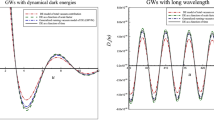Abstract
Dark energy is the dominant component of the energy density in the Universe. In a previous paper, we have shown that the collapse of dark energy fields leads to the formation of supermassive black holes with masses comparable to the masses of black holes at the centers of galaxies. Thus, it becomes a pressing issue to investigate the other physical consequences of the collapse of dark energy fields. Given that the primary interactions of dark energy fields with the rest of the Universe are gravitational, it is particularly interesting to investigate the gravitational wave signals emitted during the collapse of dark energy fields. This is the focus of the current work described in this paper. We describe and use the 3+1 BSSN formalism to follow the evolution of the dark energy fields coupled with gravity and to extract the gravitational wave signals. Finally, we describe the results of our numerical computations and the gravitational wave signals produced by the collapse of dark energy fields.
Similar content being viewed by others
References
M. J. Pierce, D. L. Welch, R. D. McClure, S. van den Bergh, R. Racine, and P. B. Stetson, Nature 371, 385 (1994).
W. L. Freedman et al., Nature 371, 757 (1994).
A. Singh, Phys. Rev. D 52, 6700 (1995).
A. K. Gupta, C. T. Hill, R. Holman, and E. W. Kolb, Phys. Rev. D 45, 441 (1992).
G.’t Hooft, in Recent Developments in Gauge Theories, Ed. by G.’t Hooft (Plenum, New York, 1980).
R. Holman and A. Singh, Phys. Rev. D 47, 421 (1993).
V. Jhalani, H. Kharkwal, and A. Singh, J. Exp. Theor. Phys. 123, 827 (2016).
E. W. Kolb and M. S. Turner, The Early Universe (Addison-Wesley, Reading, MA, 1990).
S. Weinberg, Gravitation and Cosmology (Wiley, Chichester, 1972).
J. Balakrishna et al., Class. Quant. Grav. 23, 2631 (2006).
M. Alcubierre, B. Breugmann, T. Dramlitsch, J. A. Font, P. Papadopoulos, E. Seidel, N. Stergioulas, and R. Takahashi, Phys. Rev. D 15, 124011 (2000).
T. W. Baumgarte and S. L. Shapiro, Phys. Rev. D 59, 024007 (1998) M. Shibata and T. Nakamura, Phys. Rev. D 52, 5428 (1995).
EINSTEIN TOOLKIT: A Community Toolkit for Numerical Relativity. http://www.einsteintoolkit.org.
K. Camarda and E. Swidel, Phys. Rev. D 59, 064019 (1999).
L. Rezzolla et al., Phys. Rev. D 59, 064001 (1999).
J. Baker et al., Phys. Rev. D 62, 127701 (2000).
T. Regge and J. Wheeler, Phys. Rev. 108, 1063 (1957).
F. J. Zerilli, Phys. Rev. Lett. 24, 737 (1970).
F. J. Zerilli, J. Math. Phys. 11, 2203 (1970).
V. Moncrief, Ann. Phys. 88, 323 (1974).
A. Nagar and L. Rezzolla, Class. Quantum Grav. 22, R167 (2005); Class. Quantum Grav. 23, 4297(E) (2006).
K. Thorne, Rev. Mod. Phys. 52, 285 (1980).
R. Arnowitt, S. Deser, and C. W. Misner, Gen. Relat. Gravit. 40, 1997 (2008).
K. Camarda and E. Seidel, Phys. Rev. D 59, 064019 (1999).
Author information
Authors and Affiliations
Corresponding author
Additional information
Original Russian Text © V. Jhalani, A. Mishra, A. Singh, 2017, published in Zhurnal Eksperimental’noi i Teoreticheskoi Fiziki, 2017, Vol. 152, No. 4, pp. 752–758.
Rights and permissions
About this article
Cite this article
Jhalani, V., Mishra, A. & Singh, A. Gravitational wave formation from the collapse of dark energy field configurations. J. Exp. Theor. Phys. 125, 638–643 (2017). https://doi.org/10.1134/S1063776117090035
Received:
Published:
Issue Date:
DOI: https://doi.org/10.1134/S1063776117090035



